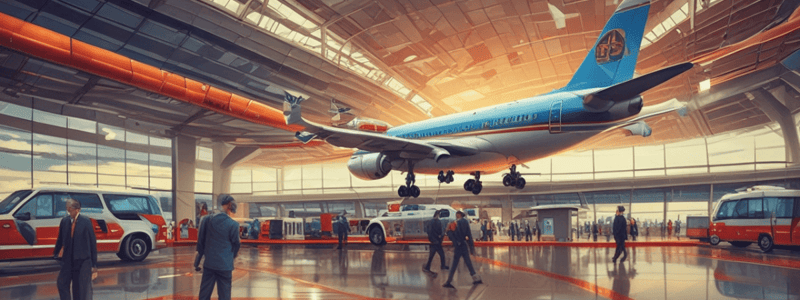Podcast
Questions and Answers
What is the primary purpose of Part 139?
What is the primary purpose of Part 139?
- To provide insurance discounts to aircraft operators
- To establish minimum safety and maintenance standards for airports (correct)
- To certify pilots for commercial flight operations
- To regulate commercial airline operations
What is required of airports under Part 139 regulations?
What is required of airports under Part 139 regulations?
- Implementation of accident prevention measures (correct)
- Installation of advanced radar systems
- Regular aircraft maintenance
- Hiring of additional security personnel
What is a benefit of basing an aircraft at a Part 139 certificated airport?
What is a benefit of basing an aircraft at a Part 139 certificated airport?
- Free maintenance services
- Lower fuel costs
- Priority boarding
- Reduced insurance premiums (correct)
What must commercial service airports demonstrate under Part 139 regulations?
What must commercial service airports demonstrate under Part 139 regulations?
What occurs before commercial flight operations are allowed at an airport?
What occurs before commercial flight operations are allowed at an airport?
What is a prerequisite for Class I airports?
What is a prerequisite for Class I airports?
What does Part 139 primarily address?
What does Part 139 primarily address?
What is required to obtain regulatory compliance?
What is required to obtain regulatory compliance?
What is the purpose of the FAA's annual inspections?
What is the purpose of the FAA's annual inspections?
Which airports are exempt from federal airport certification requirements?
Which airports are exempt from federal airport certification requirements?
What can the FAA conduct at any time?
What can the FAA conduct at any time?
What is the purpose of having a checklist of Part 139 inspection items for an airfield?
What is the purpose of having a checklist of Part 139 inspection items for an airfield?
How often must individuals with necessary access to the Movement Area be trained, according to Part 139?
How often must individuals with necessary access to the Movement Area be trained, according to Part 139?
What is the minimum duration for which airports must keep airfield inspection records, NOTAMs, fueling inspections, and accident or incident reports?
What is the minimum duration for which airports must keep airfield inspection records, NOTAMs, fueling inspections, and accident or incident reports?
How often must individuals with airfield self-inspection responsibilities be trained, according to Part 139?
How often must individuals with airfield self-inspection responsibilities be trained, according to Part 139?
What is the purpose of retaining the regularly scheduled inspection checklist, according to Part 139?
What is the purpose of retaining the regularly scheduled inspection checklist, according to Part 139?
Flashcards are hidden until you start studying
Study Notes
Part 139 Overview
- Primary purpose is to establish safety standards for airport operations and ensure compliance with federal aviation regulations.
- Requires airports serving commercial air carriers to obtain certification, ensuring they meet operational safety standards.
Requirements for Airports
- Airports must demonstrate effective safety management and operational procedures in compliance with federal regulations.
- Compliance involves maintenance of facilities, emergency response plans, and regular safety training.
Benefits of Part 139 Airports
- Basing an aircraft at a Part 139 certificated airport enhances operational safety and access to federal resources.
- It provides assurance to operators regarding regulatory compliance and safety oversight.
Demonstrations for Commercial Service Airports
- Commercial service airports must show compliance with operational safety protocols as set by Part 139.
- Facilities must pass inspections regularly to ensure adherence to standards.
Pre-Flight Operations Procedure
- Before initiating commercial flight operations, airports must complete safety inspections and certification processes.
- They must establish adequate safety facilities, personnel training, and emergency protocols.
Class I Airports Prerequisite
- A prerequisite for Class I airports is the ability to handle scheduled air carrier operations effectively.
- These airports must demonstrate sufficient infrastructure and safety measures for commercial flights.
Focus of Part 139
- Primarily addresses airport safety standards and operational protocols crucial for safe air transport.
- Includes regulations on airfield maintenance, equipment operation, and personnel qualifications.
Regulatory Compliance Requirements
- Regulatory compliance necessitates adherence to established safety rules and regulations, documented procedures and inspections.
- Continual self-assessment and corrective actions play a vital role in maintaining compliance.
FAA Annual Inspections
- The FAA conducts annual inspections to verify compliance with safety standards and operational effectiveness.
- These inspections aim to identify risks and enforce necessary corrections to maintain safety.
Exempt Airports
- Airports exempt from federal certification requirements typically involve private or general aviation facilities not serving commercial flights.
- Certain smaller airports may also qualify for exemptions based on specific criteria.
FAA Authority
- The FAA can conduct unscheduled inspections and checks at any time to ensure ongoing compliance with safety regulations.
- This flexibility allows for rapid identification and correction of potential safety issues.
Inspection Checklists
- A checklist of Part 139 inspection items serves to standardize safety checks and ensure thorough evaluations of the airfield.
- It helps streamline the inspection process and maintain consistency in safety evaluations.
Training Requirements
- Individuals with access to the Movement Area must receive training annually, reinforcing safety practices and emergency procedures.
- This training is crucial to ensure ongoing readiness and operational safety in airfield environments.
Record Keeping Duration
- Airports must retain airfield inspection records, NOTAMs, fueling inspections, and incident reports for a minimum of 24 months.
- This retention ensures that there is a history of compliance and operational integrity for review.
Self-Inspection Training
- Individuals responsible for airfield self-inspections must also be trained annually under Part 139 regulations.
- Regular training ensures they remain knowledgeable about best practices and regulatory requirements.
Regular Inspection Checklist Retention
- Retaining the regularly scheduled inspection checklist is essential to provide documentation of compliance efforts and safety practices.
- It serves as a record of audits and assessments conducted, supporting accountability and ongoing regulatory adherence.
Studying That Suits You
Use AI to generate personalized quizzes and flashcards to suit your learning preferences.




